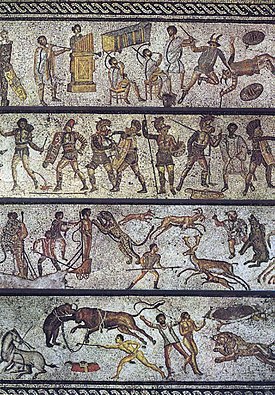Zliten mosaic
| Zliten mosaic | |
|---|---|
 |
|
| Year | 2nd century AD |
| Type | Mosaic |
| Dimensions | 573 cm × 397 cm (18 ft 10 in × 13 ft 0 in) |
| Location | The Archaeological Museum of Tripoli, Tripoli, Libya |
The Zliten mosaic is a Roman floor mosaic from about the 2nd century AD, found in the town of Zliten in Libya, on the east coast of Leptis Magna. The mosaic was discovered by the Italian archaeologist Salvatore Aurigemma in 1913 and is now on display at The Archaeological Museum of Tripoli. It depicts gladiatorial contests, animal hunts, and scenes from everyday life.
The mosaic was discovered in October 1913, in the ruins of a seaside Roman villa later called Villa Dar Buk Ammera after the area where it was found. When it was first fully unearthed and visible after the excavations conducted by Salvatore Aurigemma, from 22 June to 18 August 1914, it was immediately seen as a masterpiece of mosaic art, but one that was in an emergent need for preservation and restoration. In the 1920s, the mosaic was restored and placed on display at The Archaeological Museum of Tripoli. It moved with the museum to its new location in 1952 and is displayed prominently near the entrance hall.
There have been various disputes related to the dating of the mosaic, mostly based on archaeological or stylistic comparisons, but the issue remains unresolved.
In his work on the Zliten mosaics, Mosaici di Zliten, 1926, Aurigemma offers an approximate dating period for the mosaic in the Flavian Dynasty years (69-96 AD). This chronology would make the mosaic one of the earliest known mosaics of North Africa. He asserts his hypothesis on three arguments:
In 1965, Georges Ville studied the mosaic based on the historical evidence provided by the costumes and weaponry of the protagonists in sections of the mosaic depicting venatio (hunting) and munus (swordsmanship). Ville found that the short-sleeved tunic and the hunters with bare, unprotected legs seem to belong to the late 1st or early 2nd century AD, whereas the type of thraex and murmillo’s helmets seem to be intermediary between that of Pompeii and that of the gladiator of Trajan period. Thus, Ville dates the mosaic from the end of the Flavian period to the early Antonine period (late 1st or early 2nd century).
...
Wikipedia
